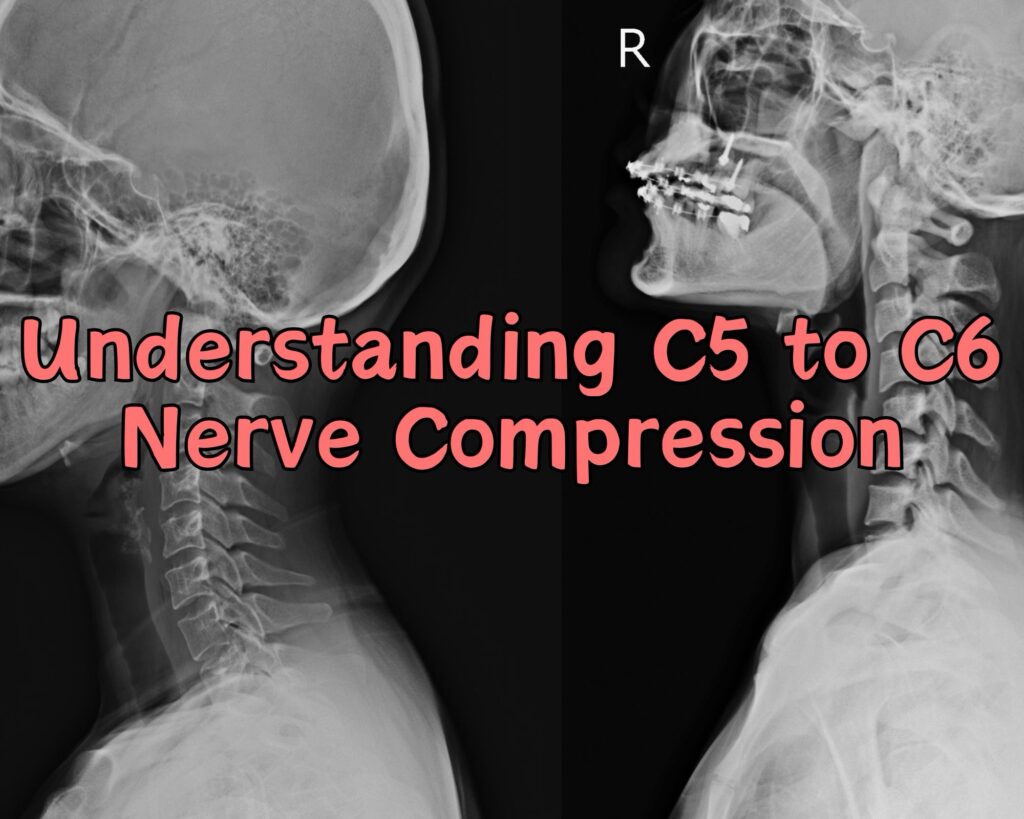Nerve compression, particularly in the C5 to C6 area of the cervical spine, can have profound effects on one’s health and well-being. Understanding the intricacies of this condition is crucial for proper diagnosis and effective management. Let’s delve into what nerve compression in the C5 to C6 region entails and its implications for overall health.

What is Nerve Compression in the C5 to C6 Area?
Nerve compression in the C5 to C6 area refers to the compression or pinching of the nerve roots exiting the spinal cord between the fifth and sixth cervical vertebrae. This compression can occur due to various factors, including degenerative changes, disc herniation, spinal stenosis, or traumatic injury.
Symptoms and Implications:
The symptoms of C5 to C6 nerve compression can manifest in various ways, depending on the severity and location of the compression. Common symptoms may include:
- Pain, numbness, or tingling in the neck, shoulders, arms, or hands
- Weakness or difficulty with fine motor skills in the arms or hands
- Radiating pain down the arm, often referred to as radiculopathy
- Muscle weakness or atrophy in severe cases
Diagnostic Evaluation:
Diagnosing C5 to C6 nerve compression typically involves a thorough medical history, physical examination, and diagnostic imaging studies such as X-rays, MRI, or CT scans. These tests help healthcare providers pinpoint the exact location and cause of the nerve compression.

Treatment Approaches:
Treatment for C5 to C6 nerve compression aims to alleviate symptoms, reduce inflammation, and address the underlying cause of compression. Depending on the severity and duration of symptoms, treatment options may include:
- Rest and activity modification
- Physical therapy and exercises to improve strength and range of motion
- Medications such as nonsteroidal anti-inflammatory drugs (NSAIDs) or muscle relaxants
- Corticosteroid injections to reduce inflammation and pain
- Surgical intervention in severe cases or when conservative measures fail to provide relief
Prognosis and Long-Term Management:
The prognosis for C5 to C6 nerve compression varies depending on factors such as the severity of compression, underlying cause, and individual response to treatment. In many cases, conservative measures can effectively manage symptoms and improve function. However, some individuals may require ongoing management or surgical intervention for long-term relief.

Symptoms of C5 to C6 Nerve Compression
Here is a list of problems that have been reported from problems in the neck of c5-c6 area. These are listed in order from most commonly reported to least reported.
1. Neck, Shoulder, and Upper Arm Pain:
- The most common symptom of nerve compression in the C5 to C6 area is pain, which often radiates from the neck to the shoulders and upper arms. This pain may vary in intensity and may be described as dull, achy, or sharp.
2. Numbness or Tingling Sensation:
- Individuals with C5 to C6 nerve compression may experience numbness or tingling sensations in the shoulders, arms, or hands. This sensation, known as paresthesia, occurs due to impaired nerve function and can range from mild to severe.
3. Weakness in Shoulders, Arms, or Hands:
- Weakness in the shoulders, arms, or hands is another common symptom of nerve compression in the C5 to C6 region. This weakness may affect grip strength, fine motor skills, and overall arm function.
4. Radiating Pain (Radiculopathy):
- Radiculopathy, or radiating pain down the arm, is a hallmark symptom of nerve compression in the cervical spine. Individuals may experience shooting or burning pain that follows the path of the affected nerve, often extending from the neck to the hands.
5. Difficulty with Fine Motor Skills:
- Compression of the C5 to C6 nerve roots can lead to difficulty with fine motor skills in the hands, such as buttoning shirts, tying shoelaces, or picking up small objects. This impairment in dexterity can significantly impact daily activities.
6. Muscle Stiffness or Spasms:
- Muscle stiffness or spasms in the neck and shoulders are common symptoms of nerve compression. These spasms may result from the body’s attempt to protect the affected area or compensate for weakness and instability.
7. Reduced Range of Motion:
- Individuals with C5 to C6 nerve compression may experience reduced range of motion in the neck, making it difficult to turn the head or tilt it from side to side. This limitation in movement can contribute to stiffness and discomfort.
8. Headaches:
- Headaches, particularly at the base of the skull, may occur as a result of muscle tension, nerve irritation, or compensatory movements due to cervical spine issues. These headaches may be persistent and worsen with certain activities.
9. Difficulty Gripping Objects:
- Weakness and numbness in the hands can lead to difficulty gripping objects or performing tasks that require fine motor skills. Individuals may struggle to hold onto items securely or experience clumsiness when handling objects.
10. Sensitivity to Touch or Pressure:
- Some individuals with C5 to C6 nerve compression may experience heightened sensitivity to touch or pressure in the neck and shoulders. Even light touch or gentle pressure may elicit discomfort or pain in the affected area.
11. Burning Sensation:
- A burning sensation along the path of the affected nerve is a characteristic symptom of nerve compression. This burning pain may be intermittent or constant and may worsen with certain movements or activities.
12. Electric Shock-Like Sensations:
- Electric shock-like sensations, often described as shooting or stabbing pain, may occur with specific movements or positions that exacerbate nerve compression. These sensations can be sudden and intense, causing significant discomfort.
13. Loss of Coordination:
- Nerve compression in the C5 to C6 area can lead to loss of coordination in the arms and hands, making it difficult to perform tasks that require precise movements. Individuals may notice clumsiness or difficulty controlling their movements.
14. Muscle Atrophy:
- In severe cases of nerve compression, muscle atrophy or wasting may occur due to prolonged nerve dysfunction. This can result in visible changes in muscle size and strength, particularly in the arms and hands.
15. Difficulty Swallowing (Dysphagia):
- While less common, some individuals with C5 to C6 nerve compression may experience difficulty swallowing, known as dysphagia. This symptom may be due to impaired nerve function affecting the muscles involved in swallowing.
16. Changes in Reflexes:
- Changes in reflexes in the arms, such as diminished or exaggerated reflex responses, may occur with nerve compression. Healthcare providers may assess reflexes as part of the diagnostic evaluation for cervical spine issues.
17. Pain Exacerbated by Neck Movements:
- Pain or discomfort in the neck and shoulders may worsen with certain movements or positions, such as turning the head or tilting it backward. These movements can further irritate the compressed nerve roots, leading to increased pain.
18. Sensation of Heaviness or Weakness:
- Some individuals with nerve compression may experience a sensation of heaviness or weakness in the arms, particularly when performing overhead activities or lifting objects. This sensation may be accompanied by muscle fatigue.
19. Fatigue or Tiredness:
- Chronic pain and muscle dysfunction associated with nerve compression can lead to fatigue or tiredness, both physically and mentally. Individuals may feel drained or exhausted despite minimal physical exertion.
20. Changes in Posture or Gait:
- Compensation for symptoms of nerve compression may lead to changes in posture or gait, as individuals adapt to reduce pain or discomfort. These changes may include alterations in spinal alignment or walking patterns.
Understanding the wide range of symptoms associated with nerve compression in the C5 to C6 area is essential for accurate diagnosis and appropriate management. If you’re experiencing any of these symptoms, it’s crucial to consult with a healthcare professional for evaluation and treatment.

Can Nerve Compression in the C5 to C6 Area Cause Blurry Vision?
I have blurry vision from time to time, and although I know sometimes I have migraines, I didn’t really know if c5 and c6 problems can cause blurry vision or not so we have to take a deep dive into this. Nerve compression in the C5 to C6 area primarily affects the upper body, including the neck, shoulders, arms, and hands. While this condition typically does not directly cause blurry vision, there are several indirect ways in which cervical spine issues may potentially affect vision:
1. Muscle Tension and Headaches:
- Chronic muscle tension and headaches associated with cervical spine issues may indirectly contribute to eye strain and blurry vision. Tension in the neck and shoulders can affect the muscles around the eyes, leading to discomfort and visual disturbances.
2. Referral Pain:
- Pain from the neck and shoulders due to nerve compression can sometimes refer to other areas, including the head and eyes. Referred pain may manifest as headaches or discomfort behind the eyes, which could potentially impact vision clarity.
3. Posture-related Issues:
- Poor posture associated with cervical spine problems may lead to changes in head and neck alignment. This can affect blood flow to the head and eyes, potentially causing temporary vision changes or discomfort.
4. Secondary Effects:
- Additionally, if nerve compression leads to significant pain or discomfort, individuals may experience stress or anxiety, which can indirectly affect vision. Stress-related eye strain or tension headaches may result in temporary blurry vision.
While blurry vision is not a typical symptom of nerve compression in the C5 to C6 area, individuals experiencing this symptom along with neck or shoulder pain should seek medical evaluation to rule out other underlying causes. It’s essential to consult with a healthcare professional for proper diagnosis and management of any vision-related concerns.
I have described my pain in my arm and shoulder for a long time in the way as if someone is trying to rip my entire arm off. In my case it’s my left arm and shoulder for the most part. It’s a terrible constant burning, pulling pain with some stabbing sensations all the way into my fingers. I also do have cubital tunnel syndrome in my elbow.

Impact of Sleep on Neck Pain
For many individuals dealing with neck pain, sleep can either provide relief or exacerbate symptoms. Interestingly, some may find that sleeping longer exacerbates their neck discomfort, leading to increased stiffness and soreness upon waking. Let’s explore why this phenomenon occurs and how it may be related to your choice of pillow.
Why Sleeping Longer May Worsen Neck Pain:
- Prolonged Static Position: When we sleep for longer periods, we often remain in one position for an extended duration. This prolonged static posture can lead to increased strain on the neck muscles and spine, particularly if the sleeping position places undue pressure on the cervical spine.
- Poor Pillow Support: The type of pillow you use and its level of support can significantly impact neck pain during sleep. If your pillow does not adequately support the natural curvature of your neck or fails to provide sufficient cushioning, it can contribute to discomfort and stiffness, especially over prolonged periods of sleep.
- Muscle Stiffness: During sleep, especially during longer periods of uninterrupted rest, muscles may become stiff and less flexible. This can be particularly problematic for individuals with neck pain, as stiff muscles may exacerbate existing discomfort and make it more challenging to find a comfortable sleeping position.
Addressing Neck Pain Associated with Longer Sleep:
- Optimize Sleeping Environment: Ensure your sleeping environment is conducive to restful sleep. This includes investing in a supportive mattress and pillows that promote proper spinal alignment and alleviate pressure on the neck and shoulders.
- Experiment with Pillow Options: Consider trying different types of pillows, such as cervical pillows or memory foam pillows, to find one that provides optimal support and comfort for your neck. The goal is to maintain the natural curvature of the spine while minimizing pressure points.
- Incorporate Neck Stretches: Incorporating gentle neck stretches before bed and upon waking can help alleviate muscle tension and improve flexibility. Consult with a healthcare professional or physical therapist for guidance on safe and effective neck stretches.
The Role of Pillow Choice in Neck Pain:
Your choice of pillow can significantly influence the impact of sleep on neck pain. If you suspect that your pillow may be contributing to your discomfort, it may be beneficial to explore alternative options that better support your neck and align your spine during sleep.
For more insights into how your pillow choice can affect neck pain, you may find the article “Neck Pain at Night: Your Pillow Might Be the Culprit” helpful. Understanding the relationship between sleep quality, pillow support, and neck pain can empower you to make informed choices to improve your overall sleep experience and alleviate discomfort.

Understanding the Relationship Between Neck Pain and Occipital Neuralgia
Neck pain, particularly when exacerbated by prolonged sleep, can indeed coincide with conditions such as occipital neuralgia, but it’s essential to understand how they differ and how they may be related.
Neck Pain and Occipital Neuralgia:
- Neck Pain: Neck pain typically refers to discomfort or stiffness in the neck area, often accompanied by restricted range of motion and muscle tension. It can result from various factors, including poor posture, muscle strain, degenerative changes in the cervical spine, or nerve compression.
- Occipital Neuralgia: Occipital neuralgia is a specific type of headache characterized by sharp, shooting pain that radiates from the base of the skull (the occipital region) to the back of the head, scalp, and behind the eyes. It occurs when the occipital nerves, which run from the top of the spinal cord to the scalp, become irritated or inflamed.
Differentiating Between Neck Pain and Occipital Neuralgia:
- Location of Pain: Neck pain typically manifests as discomfort or stiffness localized to the neck area, whereas occipital neuralgia presents with sharp, shooting pain that radiates from the base of the skull to the back of the head and scalp.
- Nature of Pain: Neck pain may be dull, achy, or throbbing, often exacerbated by certain movements or positions. In contrast, occipital neuralgia is characterized by sharp, stabbing pain that may be triggered by neck movements, touching the scalp, or even simple activities like brushing the hair.
- Underlying Mechanisms: Neck pain can result from muscle tension, strain, or structural issues in the cervical spine, while occipital neuralgia is typically caused by irritation or compression of the occipital nerves, often due to factors such as muscle spasms, nerve entrapment, or underlying medical conditions.
Relationship Between Neck Pain and Occipital Neuralgia:
While neck pain and occipital neuralgia are distinct conditions, they may be interconnected in some cases. For example:
- Chronic neck pain or poor posture can contribute to muscle tension and nerve irritation in the cervical spine, potentially exacerbating symptoms of occipital neuralgia.
- Conversely, occipital neuralgia can cause referred pain that manifests as neck discomfort or stiffness, especially if the condition leads to muscle tension or altered posture as a compensatory response.
Seeking Professional Evaluation:
If you experience neck pain along with symptoms suggestive of occipital neuralgia, such as sharp, shooting pain in the back of the head and scalp, it’s crucial to seek medical evaluation for proper diagnosis and management. A healthcare professional can perform a thorough assessment, including physical examination and diagnostic tests, to determine the underlying cause of your symptoms and recommend appropriate treatment strategies.
For further insights into occipital neuralgia and its management, you may find the article “Occipital Neuralgia: The Unseen Battle of Headaches and Heartaches” informative. Understanding the distinctions between neck pain and occipital neuralgia can help guide your healthcare journey and facilitate targeted interventions to alleviate discomfort and improve quality of life.

Exploring the Connection Between Neck Pain and Spondylitis
The presence of spondylitis in the lower back, particularly since high school, raises questions about its potential relationship to neck pain. While spondylitis primarily affects the lower back (lumbar spine) and sacroiliac joints, it can occasionally manifest in other areas of the spine, including the cervical spine. Let’s delve into whether your neck issue could be related to your history of spondylitis.
Understanding Spondylitis:
- Inflammatory Condition: Spondylitis refers to a group of inflammatory conditions that affect the spine, including ankylosing spondylitis, which is a form of arthritis that primarily affects the spine and sacroiliac joints. These conditions are characterized by inflammation, stiffness, and pain in the affected areas of the spine.
- Predominantly Affects Lower Back: While spondylitis typically affects the lower back and pelvis, it can occasionally involve other regions of the spine, including the cervical spine. However, cervical involvement is less common compared to the lumbar spine.
Possible Connection to Neck Pain:
- Extension of Inflammation: In some cases, the inflammatory process associated with spondylitis in the lower back may extend to other areas of the spine, including the cervical spine. This can result in inflammation of the cervical facet joints or other structures in the neck, leading to neck pain and stiffness.
- Altered Posture and Movement Patterns: Chronic spondylitis in the lower back can affect overall spinal alignment and posture. Compensation for lumbar spine discomfort or stiffness may lead to altered movement patterns and increased stress on the cervical spine, potentially contributing to neck pain over time.
Seeking Professional Evaluation:
Given your history of spondylitis in the lower back and the possibility of cervical involvement, it’s essential to seek professional evaluation for your neck pain. A healthcare provider, such as a rheumatologist or orthopedic specialist, can assess your symptoms, perform a comprehensive examination, and recommend appropriate diagnostic tests, such as imaging studies, to evaluate the cervical spine and assess for any signs of inflammation or structural changes.
Addressing Chronic Pain:
Living with chronic pain, whether in the lower back or neck, can be a challenging and isolating experience. It’s essential to prioritize self-care, seek support from healthcare professionals, and explore comprehensive treatment approaches tailored to your individual needs. For insights into coping with chronic pain, you may find the article “Living with Chronic Pain: A Struggle Beyond Words” informative and empowering.
By addressing both the physical and emotional aspects of chronic pain, you can take proactive steps towards managing your symptoms, improving your quality of life, and finding meaningful ways to cope with the challenges you face. Remember that you are not alone, and there are resources and support networks available to help you navigate your journey towards pain management and wellness.
The Potential Link Between C5-C6 Neck Issues and Dizziness
While neck pain and neurological symptoms like pain, numbness, and weakness in the neck, shoulders, arms, and hands are common indicators of C5-C6 nerve compression, symptoms such as dizziness, lightheadedness, or nausea are less frequently associated with this specific cervical spine problem. However, it’s essential to consider potential connections between these symptoms and C5-C6 neck issues.
Possible Relationship Between C5-C6 Nerve Compression and Dizziness:
- Referral of Symptoms: Although nerve compression in the C5-C6 area primarily impacts the upper body, it’s possible for symptoms to refer to other regions, including the head and neck. In some cases, nerve irritation or dysfunction in the cervical spine might lead to sensory disturbances or autonomic dysfunction, contributing to dizziness or lightheadedness.
- Muscle Tension and Posture: Chronic neck pain or muscle tension associated with C5-C6 nerve compression can affect overall posture and spinal alignment. Poor posture, particularly with forward head posture or cervical spine misalignment, might compromise blood flow to the brain, resulting in symptoms like dizziness or lightheadedness.
- Stress and Anxiety: Coping with chronic pain or neurological symptoms from C5-C6 nerve compression can be emotionally challenging and lead to stress or anxiety. These psychological factors can exacerbate symptoms of dizziness, lightheadedness, or nausea, particularly in individuals prone to somatic symptoms or panic attacks.
- Medication Side Effects: Patients with cervical spine issues might be prescribed medications for pain or inflammation management, which could sometimes induce side effects such as dizziness, lightheadedness, or nausea. It’s crucial to discuss any medication-related symptoms with a healthcare provider to determine if adjustments are necessary.
Well, that’s all for now. You should check out the other articles here on our website I have written about my pain journey as well as depression, anxiety, neck and back pain, dizziness, stomachs issues and much more!
While dizziness, lightheadedness, or nausea are not typical symptoms of C5-C6 nerve compression, they can sometimes be linked, directly or indirectly, to neck issues. If experiencing these symptoms alongside neck pain or neurological symptoms, it’s important to consult a healthcare provider for thorough evaluation and appropriate management.
For further insights into managing symptoms of dizziness, delving into the article “Navigating the Complexities of Dizziness: Understanding My Symptoms” could provide valuable information to address concerns effectively.
As an Amazon Associate we earn from qualifying purchases through some links in our articles.




